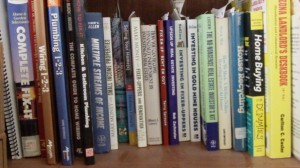The fixer-upper house business is a great business to be in these days. But, if you are just starting out, and are as green as a gourd, as I was, you need some help.
To speed up the learning processes, you need to have a collection of reference books on home repair, buying and selling houses, rental properties, tax law and all other aspects of real estate.
If a home without books is like a body without a soul, then a fixer-upper business without reference books is like a cook without a cookbook.
You may not know everything at the start of your new business and you may need help in some areas, especially in the initial stages. However, each time you pay to have someone do work for you, or go through some new process, you should observe everything, ask questions and learn the process.
That way, the next time you will be able to do it yourself, or at least perform a larger part of the project. The key is to keep doing things over and over until you master how it works. You will eventually reach a point where you make decisions of where to make repairs and which houses to buy based on your instinct.
Books will help you to reach that point sooner.
Here are some books that I have found particularly useful to have on hand:
1. Fix em Up, Rent em Out, by yours truly. Yes, believe it or not, I read my own book! Anyone who says otherwise, is just itching for a fight.
2. Investing in Fixer Uppers, by Jay DeCima. His first, and still my favorite, of his books.
3. Investing in Real Estate, by Gary Eldred.
4. Arizona Landlord’s Deskbook (or the equivalent for your state.) by Carlton Casler.
5. Real Estate Debt Can Make You Rich, by Steve Dexter.
6. Wiring 1-2-3, by Home Depot
7. Plumbing 1-2-3, by Home Depot
8. Tiling 1-2-3, by Home Depot. Are you getting the impression that I like the Home Depot books? In addition to mastering the art of tile installation, I made my first grout repair after reading this book.
9. Fix it Yourself Manual, by Reader’s Digest.
10. Upside Up Real Estate Investing, by Bob Zachmeier (teacher of the first real estate class that I took).








